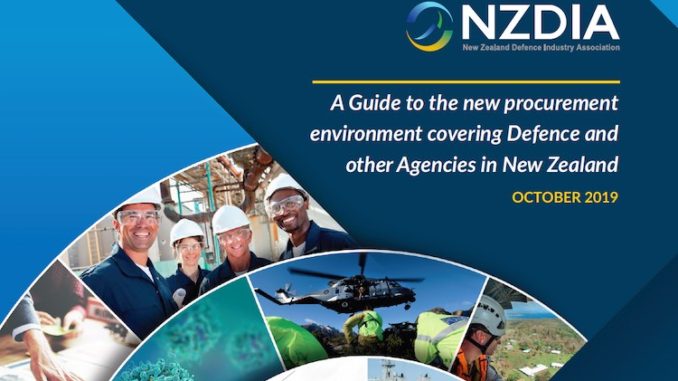
In its recently released Guide to the new procurement environment covering Defence and other Agencies in New Zealand, the NZDIA breaks down the Government Procurement Rules 4th edition.
According to Chapter 9 of the New Zealand Government Defence Capability Plan 2019 (DCP), “International prime companies submitting proposals to provide their capabilities outlined in this capability plan will be required to provide activity reports setting out the steps they have taken to identify and use New Zealand industry to supply goods and services as part of their proposal.”
This new approach reflects the agency-wide rules changes introduced on 1 October 2019 to procurement processes across the New Zealand Government. The new rules are captured in the Government Procurement Rules 4th Edition 2019 (PR4).
Even in a small country like New Zealand, public sector procurement exceeds NZ$41 billion per annum, and the government is committed to increasing engagement and opportunities for New Zealand business to be involved in government procurement. This commitment is recognised as having the potential to “increase exports and support NZ economic growth”.
The new requirements present both challenges and opportunities to industry from outside and within New Zealand. NZDIA believes that these changes will bring substantial benefits to industry and government, and we are here to support both.
The NZDIA introductory guide is designed to assist Primes and other businesses interested in pitching for work with New Zealand government agencies – and in particular with MOD and NZDF – to understand the new PR4 Rules. NZDIA is ready to assist Industry so they have the best chance of success for their business and for the New Zealand economy.
As always, a very good first step is to join NZDIA by visiting www.nzdia.co.nz and clicking on the ‘Become a Member’ link. If already a member, we encourage you to engage even more. NZDIA is the preeminent association in New Zealand connecting Defence and industry and we are working hard to deliver value to our members and support New Zealand Defence deliver to the Community, Nation and World.
Key changes
PR4 rule changes took effect on 1 October 2019. The amendments to the Rules are described as “essential in reforming government procurement to support broader social, economic, cultural and environmental outcomes…” Agencies are working through how to implement the changes.
“Through these Rules, government contracts will now be more explicitly leveraged to support broader outcomes,” states PR4. “By seeking continual innovation and requiring high standards in the procurement process, we are ensuring that those who win contracts in New Zealand can compete in the international market.”
Among the changes there is a new Supplier Code of Conduct with a Statement of Government Expectations of Suppliers. There is also a new Government Procurement Charter (GPR) setting out Government’s expectations of how each agency should conduct their procurement activity to achieve public value in areas such as the appropriate management of risk. These expectations flow down into relationships between Primes and their own supply chains.
All government agency staff engaged in procurement (i.e. not just procurement people) must now be trained in the Five Procurement Principles and the Charter, and the agency’s practices must reflect these. Businesses should also train their staff to ensure they play their part under the new rules.
Each agency must also be able to show how it has used sound research to plan an appropriate and proportionate approach-to-market strategy.
Accordingly, expect more detail in Procurement Plans. They must contain all known or anticipated contract opportunities that the Rules apply to (not just those driven by the Procurement team), and they are required to be published six-monthly (March/October) in relation to, for example, goods and services (100k plus), and recurrent contracts due for renewal.
New definitions
Important new definitions in PR4 include:
Public value (Rules 3, 12 and 46): which means the best available result for New Zealand for the money spent. It includes using resources effectively, economically and responsibly, and taking into account:
- the procurement’s contribution to the results you are trying to achieve, including any Broader Outcomes (see below) you are trying to achieve; and
- the total costs and benefits of a procurement (total cost of ownership).
The principle of public value when procuring goods, services or works does not mean selecting the lowest price but rather the best possible outcome for the total cost of ownership (over the whole-of-life of the goods, services or works).
Selecting the most appropriate procurement process that is proportionate to the value, risk and complexity of the procurement will help achieve public value.
New Zealand Business (Rule 17): is a business that originated in New Zealand (not being a New Zealand subsidiary of an offshore business), is majority owned or controlled by New Zealanders, and has its principal place of business in New Zealand (references in the DCP to New Zealand industry includes all companies located in and employing people in New Zealand).
Broader Outcomes (Rule 16): are the secondary benefits which are generated due to the way goods, services or works are produced or delivered. They include economic, environmental, social and cultural outcomes.
Designated Contracts: include ICT services/computer software, construction, security services, and light vehicles (these are contract categories identified by Cabinet in which priority outcomes must be included and published online).
Panels
All of Government (AOG) and Agency own panels will continue to be used by all agencies. Industry should watch out for opportunities to join Panels and watch out for guidance as to how goods and services work put out to Panels honours the new principles like ‘Public Value’ and delivering ‘Broader Outcomes’.
For more information on the NZDIA and on the Association’s PR4 guidance, visit www.nzdia.co.nz.









